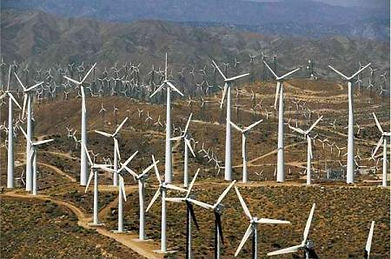Ben Stonehouse
WIND ENERGY
What is wind energy?
wind is used to generate mechanical power or electricity. Wind turbines convert the kinetic energy in the wind into mechanical power.
Advantages of wind energy
-
It's a clean fuel source. Wind energy doesn't pollute the air . Wind turbines don't produce atmospheric emissions that cause acid rain or greenhouse gases.
-
Wind is a domestic source of energy. wind supply is abundant as over the past 10 years, cumulative wind power capacity in the United States increased an average of 30% per year, outpacing the 28% growth rate in worldwide capacity.
-
It's sustainable. Wind is actually a form of solar energy. Winds are caused by the heating of the atmosphere by the sun, the rotation of the Earth, meaning it is in the long term substainable.
-
Wind power is cost-effective. It is one of the lowest-priced renewable energy technologies available today, costing between 2.44p per kilowatt-hour, depending upon the wind resource and the particular project’s financing.
-
Wind turbines can be built on existing farms . Farmers can continue to work the land because the wind turbines use only a fraction of the land benefiting the economy. Wind power plant owners make rent payments to the farmer for the use of the land, providing landowners with additional income.
-
Wind creates jobs. In 2014, the wind sector invested more than $8 billion of private capital in the U.S. economy to build projects and employed more than 73,000 workers. According to the Wind Vision Report, wind has the potential to support more than 600,000 jobs in manufacturing, installation, maintenance, and supporting services by 2050.
Disadvantages of wind energy
-
Wind energy requires expensive storage during peak production time.
-
It is unreliable energy source as winds are uncertain and unpredictable.
-
There is visual and aesthetic impact on region. wind farms are often subject to protests becuase both of the visual beauty of the area and requires large open areas for setting up the wind farms and also the noise pollution asscoiated with wind turbines.
-
The energy can only be harnessed in certain areas. Wind energy can be harnessed only in those areas where wind is strong enough and weather is windy for most parts of the year.
-
The accesibilty of the energy. Usually places, where wind power set-up is situated, are away from the places where demand of electricity is there. Transmission from such places increases cost of electricity.
-
Efficentcy of wind. The average efficiency of wind turbine is very less as compared to fossil fuel power plants. We might require many wind turbines to produce similar impact.
-
It can be a threat to wildlife. Birds do get killed or injured when they fly into turbines and the impact on habitats both on land and effecting marine environments.
-
Maintenance cost. in wind turbines is high as they have mechanical parts which undergo wear and tear over the time.
Case study- Alta Wind Energy Center, California
is the second largest onshore wind energy project in the world
As of 2013, it is the largest wind farm in the United States, with a combined installed capacity of 1,547 MW
construction, and maintenance jobs, and contribute more than one billion dollars to the local economy
The project will "reduce carbon dioxide emissions by more than 5.2 million metric tons, which is equivalent to taking 446,000 cars off the road
consistes of 320 wind turbines occupying a 9,000-acre (36 km2)


